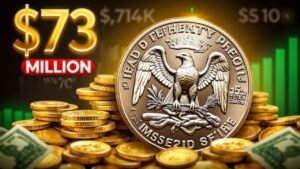Introduction
The Bicentennial Quarter, minted in 1976, was a significant milestone in American history, marking the 200th anniversary of the United States’ independence. Most of these quarters were produced for general circulation, but a few rare varieties have emerged, capturing the attention of collectors and investors alike. If you have a collection of these quarters, you may be sitting on some highly valuable coins. Here are three rare Bicentennial Quarters that stand to really be a big hit in the collectible market.
1976 No Mintmark Proof Bicentennial Quarter

The 1976 Bicentennial Quarters were struck with a special design that included a drummer boy on the reverse to commemorate the nation’s 200th birthday. However, the No Mintmark Proof variety is particularly rare and valuable. These proof quarters were supposed to carry the “S” mintmark, which indicated they were struck in San Francisco. However, in a few cases, the “S” mintmark was omitted, making these coins highly sought after by collectors.
Only a few of these No Mintmark Proofs were struck, and so this really is one of the most rare varieties of the Bicentennial Quarter. A perfect example can sell for thousands of dollars at auction, depending upon its grade.
1976-D Double Die Obverse Bicentennial Quarter

Another rare variety of the Bicentennial Quarter is the 1976-D Double Die Obverse, which features a noticeable doubling of the word “LIBERTY” on the obverse of the coin. This error was caused by a misalignment in the minting process, and it has become one of the most popular errors among collectors. The doubling effect is particularly noticeable when you closely examine the letters of “LIBERTY.”
This particular coin is considered highly valuable in mint condition, with prices potentially reaching into the thousands. Due to the unique error, finding one in good condition can be a game-changer for any collector.
1976-S Silver Proof Bicentennial Quarter

Most Bicentennial Quarters were made of copper-nickel, but the 1976-S Silver Proof Bicentennial Quarters were produced specifically for collectors and contain a higher percentage of silver. These quarters were sold in special proof sets by the U.S. Mint and are worth more than their copper-nickel counterparts.
The 1976-S Silver Proof Bicentennial Quarters came out in low mintage, and the upward movement of silver prices continues to increase the demand for the coin. It’s a must-have among collectors investing both in historical significance and precious metal value.
Why These Coins Are Valuable
These rare Bicentennial Quarters have value based on a few factors:
- Limited mintage: These varieties were minted in small quantities. As such, they are rare compared to the regular Bicentennial Quarters.
- Collector Demand: When collectors are trying to complete their collections or add the rarest pieces to their collection, the demand for these coins increases.
- Historical significance: Bicentennial quarters were struck to mark 200 years of America thus giving historical value to the coin itself.
- Condition: As it is with almost all collectibles, the finer the condition is, the costlier it goes. Coins, especially proof or error coins minted in superb condition, go for a handsome price.
Conclusion
If you’ve collected Bicentennial Quarters, the chances are a bit better there. In recent years, examples like the 1976 No Mintmark Proof, 1976-D Double Die Obverse, and the 1976-S Silver Proof will probably escalate to highly-priced items in a short period. Rare coin buyers and investors today keep their fingers crossed on these fabulous quarters. Whether you’re a seasoned collector or a newcomer, these coins offer both historical value and the potential for financial gain, making them a worthy addition to any collection.
FAQ’s
What makes a Bicentennial Quarter valuable?
Minting errors, mint marks, condition (grade), and composition (silver content).
What is a Doubled Die Obverse (DDO) error?
It’s a minting error where the design is doubled, noticeable on inscriptions or dates.
How do I know if it’s a silver Bicentennial Quarter?
Look for the “S” mint mark and weigh the coin; silver quarters weigh about 6.25 grams.


